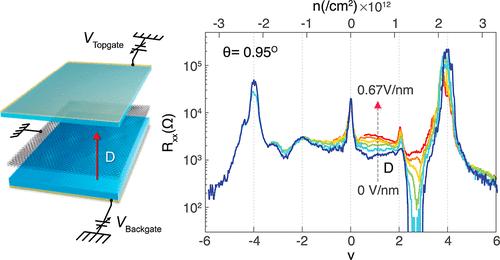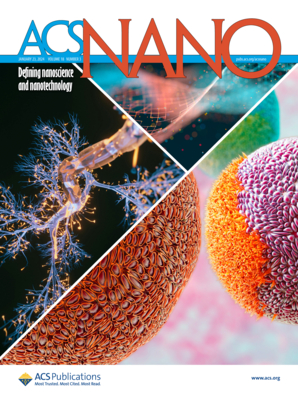Electric Field-Tunable Superconductivity with Competing Orders in Twisted Bilayer Graphene near the Magic Angle
IF 16
1区 材料科学
Q1 CHEMISTRY, MULTIDISCIPLINARY
引用次数: 0
Abstract
Superconductivity (SC) in twisted bilayer graphene (tBLG) has been explored by varying carrier concentrations, twist angles, and screening strength, with the aim of uncovering its origin and possible connections to strong electronic correlations in narrow bands and various resulting broken symmetries. However, the link between the tBLG band structure and the onset of SC and other orders largely remains unclear. In this study, we address this crucial gap by examining in situ band structure tuning of a near magic-angle (θ ≈ 0.95°) tBLG device with a displacement field (D) and reveal competition between SC and other broken symmetries. At zero D, the device exhibits superconducting signatures without the resistance peak at half-filling, a characteristic signature with a strong electronic correlation. As D increases, the SC is suppressed, accompanied by the appearance of a resistance peak at half-filling. Hall density measurements reveal that at zero D, SC arises around the van Hove singularity (vHs) from an isospin or spin-valley unpolarized band. At higher D, the suppression of SC coincides with broken isospin symmetry near half-filling with lifted degeneracy (gd ∼ 2). Additionally, as the SC phase becomes weaker with D, vHs shifts to higher fillings, highlighting the modification of the underlying band structure with the applied electric field. These findings, with recent theoretical study on SC in tBLG, highlight the competition, rather than being connected concomitantly, between SC and other orders promoted by broken symmetries.

在魔角附近扭曲双层石墨烯中具有竞争序的电场可调谐超导性
通过改变载流子浓度、扭转角度和筛选强度,研究了扭曲双层石墨烯(tBLG)中的超导性(SC),目的是揭示其起源以及与窄带强电子相关和各种由此产生的对称性破断的可能联系。然而,tBLG带结构与SC和其他目的发生之间的联系在很大程度上仍不清楚。在这项研究中,我们通过检测具有位移场(D)的近幻角(θ≈0.95°)tBLG器件的原位带结构调谐来解决这一关键差距,并揭示SC和其他破缺对称性之间的竞争。在零D时,器件表现出超导特征,没有半填充时的电阻峰值,这是一种具有强电子相关性的特征特征。随着D的增加,SC被抑制,并在半填充时出现一个电阻峰。霍尔密度测量显示,在D为零时,SC在范霍夫奇点(vHs)周围从同位旋或自旋谷非极化带产生。在较高的D下,SC的抑制与半填充附近的同位旋对称性破坏相一致,并伴有简并度的提升(gd ~ 2)。此外,随着SC相随着D变弱,vHs向更高的填充转移,突出了外加电场对底层能带结构的修饰。这些发现,结合最近对tBLG中供应链的理论研究,突出了供应链与其他订单之间的竞争,而不是由破对称促进的联系。
本文章由计算机程序翻译,如有差异,请以英文原文为准。
求助全文
约1分钟内获得全文
求助全文
来源期刊

ACS Nano
工程技术-材料科学:综合
CiteScore
26.00
自引率
4.10%
发文量
1627
审稿时长
1.7 months
期刊介绍:
ACS Nano, published monthly, serves as an international forum for comprehensive articles on nanoscience and nanotechnology research at the intersections of chemistry, biology, materials science, physics, and engineering. The journal fosters communication among scientists in these communities, facilitating collaboration, new research opportunities, and advancements through discoveries. ACS Nano covers synthesis, assembly, characterization, theory, and simulation of nanostructures, nanobiotechnology, nanofabrication, methods and tools for nanoscience and nanotechnology, and self- and directed-assembly. Alongside original research articles, it offers thorough reviews, perspectives on cutting-edge research, and discussions envisioning the future of nanoscience and nanotechnology.
 求助内容:
求助内容: 应助结果提醒方式:
应助结果提醒方式:


